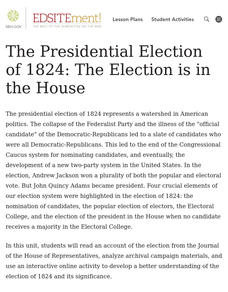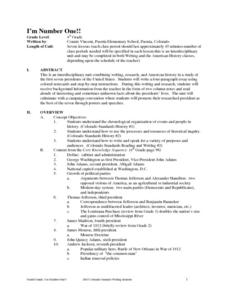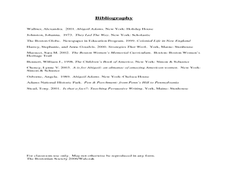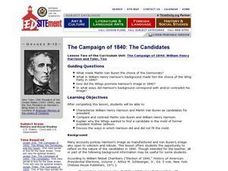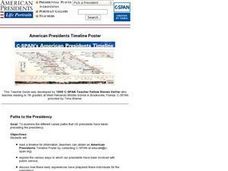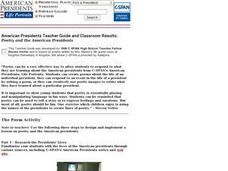Curated OER
The Election Is in the House: Was There a Corrupt Bargain?
Students take a stand, supported by evidence, on whether there was a "corrupt bargain" between Henry Clay and John Quincy Adams.
Curated OER
Introduction to Abigail Adams
Remember this lady! Abigail Adams, the wife of John Adams, the second President of the United States, and the mother of the sixth president, John Quincy Adams, was much more than a wife and mother. This prolific letter writer is the...
Curated OER
The Monroe Doctrine: Whose Doctrine Was It?
Was James Monroe the sole contributor of the Monroe Doctrine? Young scholars study the doctrine and cite evidence to show contributions of John Quincy Adams and Thomas Jefferson in its formulation.
Curated OER
Abigail as Mother (Part II)
Different tones for different audiences. That's the big idea behind the second lesson in a two-part series that reveals Abigail Adams as a mother. Scholars examine letters Abigail Adams wrote to her sons, John Quincy Adams and Charles...
Curated OER
The Election Is in the House: The Presidential Election of 1824
Students read an account of the election from the Journal of the House of Representatives, analyze archival campaign materials, and use an interactive online activity to develop a better understanding of the election of 1824 and its...
Curated OER
I'm Number One!
Fourth graders complete a unit of lessons on the first seven presidents of the U.S. They conduct research, write a four-paragraph essay, and create posters and speeches for a simulated campaign convention.
Curated OER
Figuratively Speaking
Students create 8 inch, or bigger, clay sculptures of the human form in this Art lesson introducing clay sculpting techniques. The works of artists studied in preparation include Henry Moore, Michelangelo, Degas, Rodin and John Quincy...
Curated OER
Abigail Adams: Integrating Social Studies and Language Arts
Third graders increase reading strategies while learning about Abigail Adams and her role in history. In this Abigail Adams lesson, 3rd graders read about the American Revolution and Abigail Adams using all the balanced literacy...
Curated OER
Like Father, Like Son: Presidential Families
Students examine the role of the President. They discuss the President's responsibilities and compare both father/son presidents (Adams and Bush).
Curated OER
The Campaign of 1840: William Henry Harrison and Tyler, Too
Students list some issues important during the campaign of 1840. They compare and contrast the careers of Martin Van Buren and William Henry Harrison before they became president and explain why the Whigs wanted to find a candidate in...
National Endowment for the Humanities
The Monroe Doctrine: A Close Reading
Students identify specific passages in the Monroe Doctrine to events in early U.S. diplomacy.
National Endowment for the Humanities
The 1828 Campaign of Andrew Jackson: Expansion of the Voting Base
Students give examples to indicate how the franchise was extended and limited in the first half of the 19th century, and cite some differences in the newly enfranchised population that could affect the way they would vote.
Curated OER
The Campaign of 1840: The Candidates
Learners compare and contrast William Henry Harrison and Martin Van Buren as candidates for president. They explain why the Whigs wanted to find a candidate in the mold of former president Andrew Jackson and discuss whether Harrison fit...
Curated OER
The Monroe Doctrine: President Monroe and the Independence Movement in South America
Students identify conditions in Europe that relate to the independence movements in South America and list reasons why President Monroe gave for recognizing the independence movement in South America.
Curated OER
The Campaign of 1840: The Campaign
Students discuss the use of visual images, objects, and spectacle in the 1840 campaign, then take a stand: Was the campaign of 1840 based more on substance or image?
Curated OER
The Campaign of 1840: The Whigs, the Democrats, and the Issues
Students reflect on the nature of the campaign of 1840. They identify the positions of the Democrats and the Whigs and their basic differences.
National First Ladies' Library
Blunders on All Sides: The Battle of Bunker Hill
High schoolers investigate the concepts surrounding the historical battle of Bunker Hill while conducting online research using a variety of resources. The information is used in order to create a newspaper article telling about the...
Curated OER
Perks and Perils
Students research the life of the first family. In this U.S. Government lesson, students take a White House quiz, read an article about the first family and write in their journals about a typical day in their lives versus what a day...
Curated OER
Why a President? Why not a King?
Students research how and why a country elects to have an executive branch of the government. They study the office of the Presidency of the US.
Curated OER
The U.S. Presidents
Students identify the Presidents of the U.S. by their physical characteristics and their impact on America. In this Presidents lesson plan, students read about each President, look at their pictures, and identify each of them based on...
Curated OER
The Monroe Doctrine: U.S. Foreign Affairs (circa 1782-1823) and James Monroe
Young scholars read the test of the Monroe Doctrine then list the key points and discuss its central tenets.
Curated OER
Paths to the Presidency
Seventh graders investigate a timeline of the career paths that US presidents took before they became the president. They how these career choices prepared these men for the presidency.
Curated OER
Using Primary Sources: Letters from the Presidents
Learners research the life of a president by reading personal letters on the American Presidents web site, and explore the ways that the character and personality of the president affected the ways they handled historical events.
Curated OER
Poetry and the American Presidents
Fifth graders choose a poetry activity in order to focus their research about American presidents.






